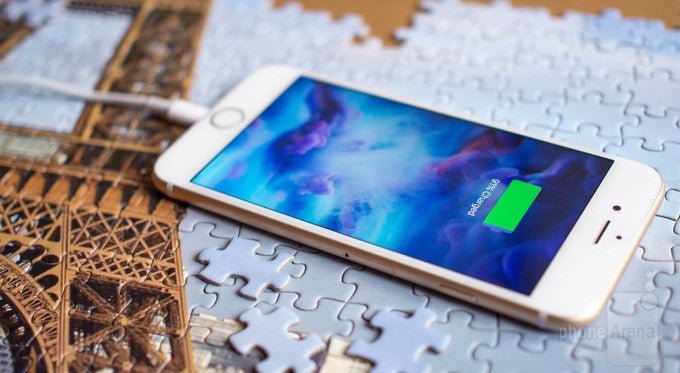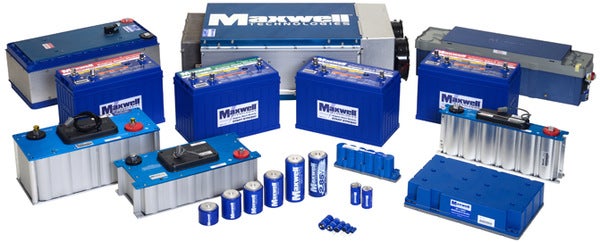Future smartphones may charge faster and last longer thanks to supercapacitor technology

Batteries vs capacitors: what's the difference?
Batteries come in many shapes, sizes, and types. The ones that all modern cellphones use are rechargeable lithium-ion batteries, which are known for their high energy density. This means they can store a lot of charge in a battery unit that's small and light, which makes them perfect for use in portable electronics.
Unlike batteries, capacitors have the ability to charge and discharge extremely quickly, which makes them great for zapping students in physics class. On the other hand, they store a very tiny amount of charge for their size. If a capacitor with the energy capacity of an iPhone's battery was ever designed, you'd need a van to move it around. These are just a few of the many factors setting batteries and capacitors apart, but they're enough to give you an idea why a common capacitor can't power a smartphone.

This particular battery cell (left) can store 1800 times more energy than the cap next to it
So what are supercapacitors then?
The properties of existing supercapacitors (also called ultracapacitors) put them somewhere between batteries and regular capacitors. They can store a reasonable amount of charge – still far from what a battery can hold, but a hundred times more than a capacitor of the same size. Also, supercapacitors can be charged much faster than a lithium battery, won't degrade as quickly over time, and have greater tolerance for extreme temperature.
Current supercapacitors can't replace the battery inside a smartphone, but advancements in the field could make that a reality one day. Imagine a smartphone battery that charges in seconds and performs like new even after a decade of use. That would be awesome, no doubt about it.

Supercapacitors come in many different sizes and are used for both commercial and industrial applications. However, these can't yet replace a phone's battery
What's the future of supercapacitors?
One thing's certain: next year's flagships won't be powered by a supercapacitor, as a contemporary supercap of practical size can't hold enough charge. Actually, we could be a decade or more away from the launch of such a phone. But research is being done by a number of institutions with the goal of discovering ways to increase supercapacitors' energy storage abilities. One of the teams working towards the goal is at the University of Central Florida and recently published an article highlighting their progress. And their research results sound optimistic: the team has developed a new process for making supercapacitors with higher energy density. This has been achieved through the use of nanomaterials – conductors 100,000 times thinner than a human hair – for storing and transferring charge. On top of that, UCF's supercaps are flexible and can endure 30,000 recharge cycles without failing.

A supercapacitor developed at the University of Central Florida
"If they were to replace the batteries with these supercapacitors, you could charge your mobile phone in a few seconds and you wouldn’t need to charge it again for over a week," said Nitin Choudhary, a postdoctoral associate who conducted much of the research published recently in the academic journal ACS Nano.
And you know what, it is not impossible for Nitin's predictions to come true. But there's still a number of considerable obstacles researchers in the field have to overcome.
What are the challenges supercapacitor technology is facing?
For starters, safety is an issue that has to be addressed. As I pointed out already, capacitors and supercapacitors can discharge rapidly, and the failure of one could result in sparks that would make the Galaxy Note 7 fiasco look like lighting up candles around the bathtub to set the mood.
Then there's the promise of ultra-fast charging. Technically, charging a supercapacitor in a matter of seconds is possible, but in practice, you'll need a massive power supply to pull this off – a charger the size of a football, perhaps. Or a lightning strike. Charging over the course of several minutes is a lot more realistic of a scenario, but you'd still need a charger the size of a laptop's power supply.
And no less importantly, there's cost. It's going to take a tremendous amount of research and development until a supercapacitor worthy of replacing a smartphone battery becomes feasible. All of that is going to require a lot of money, effort, and time. If they ever become a practical reality, these supercapacitors will be very expensive at first, which would certainly impact the cost of phones that might use them.
But the latter is a challenge every emerging tech has to face, and overcoming it is definitely possible. Back in the old days, only the best phones had a lithium battery, a color screen, and/or a camera. Today, it is hard to find a phone without these. Technology and science know no rest, folks, and an alternative to Li-Ion batteries will surely come. Will it be a next-generation supercap? Only time will tell.













Things that are NOT allowed: